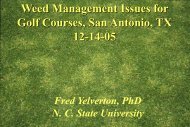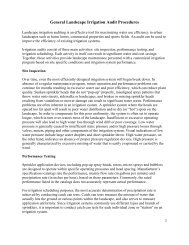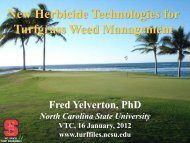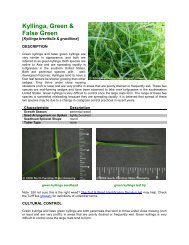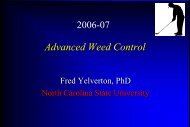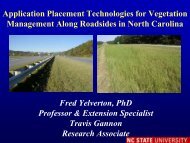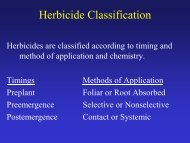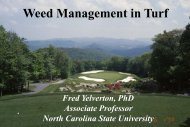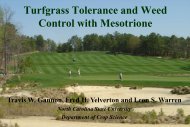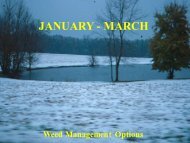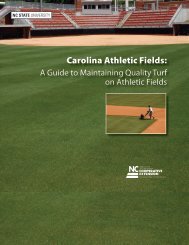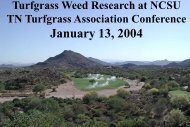Weed Presentation - TurfFiles - North Carolina State University
Weed Presentation - TurfFiles - North Carolina State University
Weed Presentation - TurfFiles - North Carolina State University
- No tags were found...
Create successful ePaper yourself
Turn your PDF publications into a flip-book with our unique Google optimized e-Paper software.
www.turffiles.ncsu.eduNew and Innovative <strong>Weed</strong>Management for TurfgrasesFred Yelverton, PhD<strong>North</strong> <strong>Carolina</strong> <strong>State</strong> <strong>University</strong>
Soil Temps For <strong>Weed</strong> Germination<strong>Weed</strong> Species Critical Soil Temp ( F)Crabgrass (Large andSmooth)55Goosegrass 60Barnyardgrass 60Foxtails (Yellow orGreen)65From Managing Turfgrass Pests, Watschke et al.
% CrabgrassEffect of Mowing Height on CrabgrassIncidence in Tall fescue807060a79a7450403020b311001.0" 2.0" 3.0" 4.0"Mowing HeightData Collected: 09-13-07, LSD (P=0.05), Sandhills Research Station, Sodman 90/10(mixture w/ bluegrass)c0
1” 2”3” 4”
Quinclorac• New Drive XLR8 formulation,• BASF Corp.• Liquid formulation• Good on small crabgrass and largecrabgrass but not intermediate size• Will control foxtails but not goosegrass
Smooth and large Crabgrass (Digitaria spp.)
• Manufactured by:– PBI/Gordon• Active ingredients: • Mode of action:– Quinclorac (8.43%) – Synthetic auxin/cellulose inhibitor– Sulfentrazone (0.69%) – PPO/Protox inhibitor– 2,4-D (11.81%)– Synthetic auxin– Dicamba, (1.49%) – Synthetic auxin• Postemergent activity• EPA reg. no. 2217-930
Q4 1.54LPBI-GordonQuinclorac + Sulfentrazone + 2,4-D amine + DicambaCool season turf onlyRate: 7 to 8 pt/A on crab, signalgrass, foxtail, broadleavesApply to seedlings after 2 nd or 3 rd mowing or 28 days afteremergenceSpray 3 to 4 weeks after sodding, sprigging or pluggingCan seed 4 weeks after application
• Tolerant turf speciesQ4 Plus– Perennial ryegrass– Kentucky bluegrass– Annual bluegrass− Rough bluegrass− Fescue species− Do not apply to solid fine fescue stand
Q4 Plus usage rates and sites• Cool-season turf– 7-8 pints/Acre• May discolor fine fescue• Bermudagrass– 5-7 pints/Acre• May discolor commonand hybrids• Where to use– Residential areas– Recreational areas– Golf courses– Streets– Athletic fields– Right-of-ways– Sod production
T-Zone 2.5LTriclopyr (8.4%) + sulfentrazone (0.73%) + 2,4-D (32%) + dicamba (2.4%)•PBI/Gordon Corporation,•Controls many tough weeds such as̵Wild Violets,̵Yellow Nutsedge suppression̵Ground Ivy,̵Oxalis̵Black Medic•All cool-season turfgrasses,•Bermudagrass, zoysiagrass, &bahiagrass.
Sulfentrazone + Quinclorac (75WG)25% + 50%FMCTolerant to bermudagrass, centipedegrass, zoysiagrass,seashore paspalum, as well as tall fescue, Ky. bluegrassand perennial ryegrassRate: 1 to 2 lb/A with no spray adjuvant neededAfter treatment, wait 1 month to reseed, overseed or sprigEstablish sod for 3 months and wait 3 month before harvestControls crabgrass, 1-4 lf goosegrass, foxtail, yellownutsedge, kyllinga species and broadleaf weedsSome pre activity
• Carfentrazone (3.9%) + Quinclorac (66.1%)• 70WDG• FMC Corp.,• Residential, commercial lawns, athletic fields, sod farmsgolf course fairways and roughs,• Warm-season turf except St. Augustinegrass @ 12 to 18oz/acre,• Most cool-season turfgrasses at 8 to 12 oz/acre,• Controls broadleaves, yellow nutsedge, crabgrass,foxtail + others.• Can be applied 1 day prior or 7 days after seeding.
• Metsulfuron (6%) + Sulfentrazone (60%) – 66WDG• FMC Corp.,• Residential, commercial lawns, athletic fields, sod farmsgolf course fairways and roughs,• Bermuda, zoysia, centipede, St. Augustine @ 6.5 to 10oz/acre,• Kentucky bluegrass & tall fescue at 3.25 to 6.5 oz/acre,• Controls many broadleaves, wild garlic, yellow nutsedge,sedge and kyllinga species, foxtail + others.• Wait 1 month after applying to reseed or sprig and wait 6to 8 weeks to overseed perennial ryegrass ; wait 3months for sod establishment before applying
ProSedge• Manage, Sedgehammer• Manufactured by:– Nufarm• Active ingredient:– Halosulfuron (75%)• Mode of action– Acetolactate synthase(ALS) inhibitor• Postemergent activity• EPA reg. no. 228-702
• Turf Safety:– Ky. Bluegrass and centipedegrass most tolerant– Tall fescue moderately tolerant– Ryegrass, St. Augustinegrass, & fine fescue have“tolerable” registration.– Bentgrass, bermudagrass, zoysiagrass - low tolerance,– Turf injury increases with heat & drought.• Rates: 4 to 8 oz/a (0.125 to 0.25 lb ai/a, 0.14 to0.28 kg ai/ha) twice 2 to 3 weeks apart.• Golf, sod, residential and commercial properties,
Mesotrione 0.25 lb ai applied May 1 (1-3 lfcrabgrass), photo taken June 14
Mesotrione 0.25 lb ai applied June 6 (5-7 lfcrabgrass), photo taken June 14
Tenacity• A new chemical class – Triketones• Active ingredient – 40% Mesotrione• Formulation – 4SC• Signal word – Caution• For Use by Professional Applicators• Do not enter treated areas until spray has dried
34 Dicot and 11 Monocot Species onTenacity Label Including:• Crabgrass spp. • Speedwell• Goosegrass• Lawn burweed• Nimblewill• Dandelion spp.• Bentgrass• Canada thistle• Oxalis• Yellow nutsedge• Buckhorn plantain • Yellow foxtail• Clover spp.• Ground IvyThis list will expand as research and commercial use find new species.
Turfgrass Tolerance to TenacityTall FescueKY BluegrassPerennial RyegrassCentipedegrassSt Augustinegrass
Bentgrass Contamination
Nontreated photo taken 4-28-06
Tenacity 0.125 fb 0.125 fb 0.125 fb 0.125 phototaken 4-28-06
Bentgrass Reduction after 3 Fall Applications ofMesotrione at 0.167 lbs ai/AUntreatedTreated with Mesotrione
POST Control in Native AreasBroadleaf <strong>Weed</strong>s:Aminocyclopyraclor (Imprelis 2 SL)Broad-spectrum broadleaf weedsLower rates where bentgrass is inmixuture.Be careful of grass species!!!
90%+ Control with AminocyclopyrachlorDogfennelBuckhorn plantainCurly dockBroadleaf plantain<strong>Carolina</strong> geranium Bracted plantainDichondraFlorida pusleyPurple cudweed FacelisWhite cloverBrazilian catsearHop cloverWild violetHenbitGoldenrodPurple deadnettle Broadleaf pink purslaneCommon lespedeza Hairy buttercupCommon chickweed Lawn burweedCommon dandelion DollarweedHorseweedVirginia buttonweedAnnual blue-eyed grass Florida betony
IntroductionAminocyclopyrachlorKJM44 – methyl ester form (tested early)MAT28 – acid formHerbicide developed by DuPont for selectiveweed control in turfIndustrial vegetation managementRange and pastureSpecialty crops – rice, fruit, sugarcaneRow crop – corn, burndownProjected release – late-2010
IntroductionPyrimidine carboxylic acidSynthetic auxinAbsorption and translocationSystemic, phloem and xylem mobile, absorbedby roots and leavesTranslocated throughout plant, accumulates inmeristematic regionsFoliar and residual control of perennial andannual weedsAverage soil half-life:37 – 103 d (turf)80 – 164 d (bare dissipation)
Synthetic Auxin TranslocationShoot MeristemRoot Meristem
Synthetic Auxin Injury
Aminocyclopyrachlor• Discovered by DuPont CropProtection– DPX -KJM44:• Methyl Ester Formulation– DPX -MAT28:• Acid Formulation• Mode of Action– Pyrimidine CarboxylicAcid– Synthetic Auxin Family• Chemistry closely related toaminopyralid (Milestone)DPX-KJM44AminopyralidDPX-MAT28
IntroductionCool-season turfgrass toleranceBentgrass (Agrostis spp.) - Do not exceed 3 oz/aKentucky bluegrass (Poa pratensis)Chewing/creeping red fescue (Festuca rubra)Sheep fescue (Festuca ovina)Tall fescue (Lolium arundinaceum)Perennial ryegrass (Lolium perenne)
% PhytotoxicityTolerance of tall fescue to Imprelis100LSD = NSLSD = NSfl oz/a80602.95.78.611.417.1402000 0 0 0 0 0 0 0 0 014 28DATTreatments applied 27 March 2006.
Tolerance of tall fescue to Imprelis with varioussurfactants (12 fl oz/a)% Phytotoxicity100LSD = NSLSD = 3.6 LSD = 4.780AloneMSO (1.5 pt)6040X-77 (0.25%)Silwet (0.25%)Agridex (1%)20008 910 118 94 5 6 60 0 0 01 WAT 2 WAT 4 WATTreatments applied 01 July 2008.
NontreatedPhoto taken 6-10-10
Imprelis 4.5 03 MayPhoto taken 6-10-10
Imprelis 6 03 MayPhoto taken 6-10-10
Trimec 03 MayPhoto taken 6-10-10
Dimension 03 MayPhoto taken 6-10-10
Drive 03 MayPhoto taken 6-10-10
Tall Fescue ToleranceTall Fescue is tolerant to Imprelis atany stage of growth.
% PhytotoxicityTolerance of Fine Fescue to Imprelis100LSD = 5.4LSD = 10.3 LSD = 2.8Oz/a3804.566094020011916810 115340 0 014 28 42DATImprelis 2SL applied 22 October 2010.
Percent Visual Injury (0-100%)Tolerance of ‘A1/A4’ CreepingBentgrass to Imprelis Applied 10 May100Imprelis (0.75 oz/A)80Imprelis (1.5 oz/A)Imprelis (3 oz/A)6040200964 5 653 3 4 53 41 0 0 0 0 0 0 1 0 0 0 0 0 0 0 0 0 0 0 014 DAI 30 DAI 59 DAI 88 DAILSD = 3.2 LSD = 2.1 LSD = 3.4 LSD = NSImprelis (0.75 oz/A) fbImprelis (0.75 oz/A)Imprelis (1.5 oz/A) fbImprelis (1.5 oz/A)Imprelis (3 oz/A) fbImprelis (3 oz/A)Imprelis (3 oz/A) fb<strong>Weed</strong>ar 64 (0.25 lbs ai/A)NontreatedApplication A (10 May 2010) & Application B (07 July 2010).
Percent Visual Injury (0-100%)Tolerance of ‘A1/A4’ Creeping Bentgrassto Imprelis Applied 02 August100Imprelis (0.75 oz/A)8070Imprelis (1.5 oz/A)Imprelis (3 oz/A)6054Imprelis (0.75 oz/A) fbImprelis (0.75 oz/A)40384141Imprelis (1.5 oz/A) fbImprelis (1.5 oz/A)200131452030231813118663440 0 00Imprelis (3 oz/A) fbImprelis (3 oz/A)Imprelis (3 oz/A) fb<strong>Weed</strong>ar 64 (0.25 lbs ai/A)Nontreated16 DAI 31 DAI 42 DAILSD = 9.4 LSD = 6.8LSD = 9.9Application A (02 August 2010) & Application B (04 September 2010).
% ControlImprelis for dandelion control100806098LSD = NSLSD = NS100 100 100 100 100oz/a34.564020028 56DATImprelis applied 18 April 2007.
% ControlImprelis for white clover control applied with LCO gun(28 DAT)10080LSD = NSLSD = NS100 100 100 100fl oz/a34.56040200April 13 May 20AppliedTreatments applied 13 April or 20 May 2009.
% ControlImprelis for white clover control applied with LCO gun(56 DAT)10080LSD = NSLSD = NS100 100 100 100fl oz/a34.56040200April 13 May 20AppliedTreatments applied 13 April or 20 May 2009.
% ControlImprelis for buckhorn plantain control1008084LSD = NSLSD = NS98 999698100oz/a34.56064020056 81DATImprelis applied 25 May 2007.
% ControlImprelis for henbit control56 DAT100806040LSD = 13.8 LSD = 11.261100 100 10050fl oz/a1.42.94.35.7202124310JanuaryMarchAppliedTreatments applied 09 January 2007 or 07 March 2007.
% ControlImprelis for henbit control10080LSD = NS100 100 100 96Imprelis 3 ozImprelis 4.5 ozImprelis 6 ozEscalade 3 pt604020055 DATTreatments applied 22 October 2010. Rates are per acre.
% ControlImprelis for corn speedwell control64 DAIT100LSD = 22.088 Imprelis 3 oz80687173Imprelis 4.5 oz6059Imprelis 6 oz40200080 0Feb 24 Feb 24 fb Mar 23 Feb 23 fb Apr 06Treatments applied 23 February, 23 March, 06 April 2009.
Smooth and large Crabgrass (Digitaria spp.)
% ControlImprelis for smooth crabgrass control1008081LSD = 18.38893AE 10 ozIM 3 ozIM 4.5 ozAE + IM 10 + 3 ozAE + IM 10 + 4.5 oz6056402920060 DATTreatments applied 02 June 2010. AE – Acclaim Extra.Rates are per acre. DIGIS: 4 leaf – 2 tiller at application.
% ControlImprelis for smooth crabgrass control1008073LSD = 18.39189AE 20 ozIM 3 ozIM 4.5 ozAE + IM 20 + 3 ozAE + IM 20 + 4.5 oz6056402920060 DATTreatments applied 02 June 2010. AE – Acclaim Extra.Rates are per acre. DIGIS: 4 leaf – 2 tiller at application.
% ControlSmooth Crabgrass Control with Imprelisand Escalade1008689994.5 oz80686 oz60Escalade 3 pt40LSD =21.02000 01 app 2 apps2009: Orange County. Sequential application made 4 wks after initial. Trts initiatedMay 25, evaluations collected Sept 09. Crabgrass was < one tiller at initiation.
% ControlCrabgrass Control with Imprelis(At fescue seeding)100806056686584100 99 954.5 oz6 oz4.5 fb 4.5 oz6 fb 6 ozDimensionDriveTrimec40LSD =24.02002010: Wake County. Trts applied May 03. Data collected 6-15-10, 43 DAIT.Sequential application made 4 wks after initial. 1-3 leaf crabgrass.
‘Tifway’ Bermudagrass 11 DATDPX-MAT28: LowDRYWET
Concentration - PPM (mg/kg)Turfgrass Clipping ResiduesAverage of 2 Field Trials at NC <strong>State</strong> – 2009 - 20103530AminocyclopyrachlorClopyralid25201510500 1 3 7 14 25 40 54Days After Application
Imprelis Composting StudyOhio – 2008“Both the free acid and methyl ester ofaminocyclopyrachlor in both granular and liquid(formulations) were more biodegradable thanclopyralid during composting”Dr. Frederick MichelDepartment of Food, Agricultural & Biological EngineeringOhio <strong>State</strong> <strong>University</strong>
DuPont Imprelis LabelRestrictions
Imprelis Treated Turf - ClippingsClippings should be returned.Some desirable plants can be injured ifclippings are used as mulch. Thismostly applies to legumes.
SummaryImprelis has good activity on a largenumber of weed species found in lawns.Controls many difficult to controlweeds.Tall Fescue is tolerant at any stage ofgrowth.
Questions?



